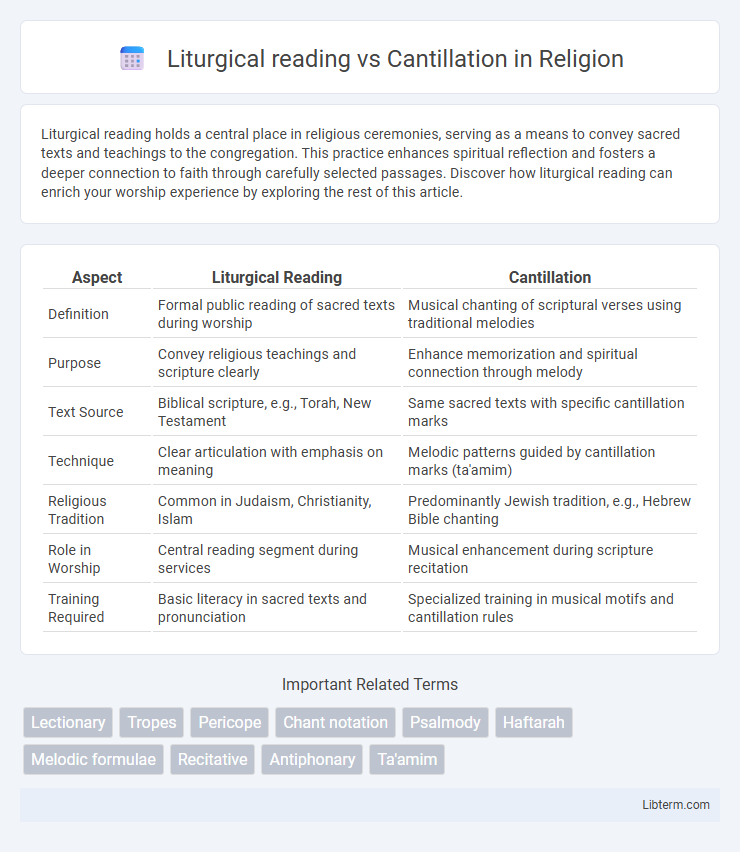Liturgical reading holds a central place in religious ceremonies, serving as a means to convey sacred texts and teachings to the congregation. This practice enhances spiritual reflection and fosters a deeper connection to faith through carefully selected passages. Discover how liturgical reading can enrich your worship experience by exploring the rest of this article.
Table of Comparison
| Aspect | Liturgical Reading | Cantillation |
|---|---|---|
| Definition | Formal public reading of sacred texts during worship | Musical chanting of scriptural verses using traditional melodies |
| Purpose | Convey religious teachings and scripture clearly | Enhance memorization and spiritual connection through melody |
| Text Source | Biblical scripture, e.g., Torah, New Testament | Same sacred texts with specific cantillation marks |
| Technique | Clear articulation with emphasis on meaning | Melodic patterns guided by cantillation marks (ta'amim) |
| Religious Tradition | Common in Judaism, Christianity, Islam | Predominantly Jewish tradition, e.g., Hebrew Bible chanting |
| Role in Worship | Central reading segment during services | Musical enhancement during scripture recitation |
| Training Required | Basic literacy in sacred texts and pronunciation | Specialized training in musical motifs and cantillation rules |
Introduction to Liturgical Reading and Cantillation
Liturgical reading involves the public recitation of sacred texts, following precise vocal patterns and traditional intonations that preserve the spiritual and communal essence of the scriptures. Cantillation is the melodic chanting of these texts, using specific musical motifs called trope marks to guide pronunciation, rhythm, and emphasis, enhancing comprehension and memorization. Both practices serve to transmit scriptural meaning, but cantillation uniquely integrates musical elements that underscore textual nuances in religious services.
Historical Background of Liturgical Practices
Liturgical reading in religious traditions dates back to ancient scriptural recitations used to preserve oral teachings and ensure accurate transmission, particularly in Jewish and Christian worship. Cantillation evolved as a melodic system that guides the chanting of sacred texts, originating in the Masoretic tradition between the 7th and 10th centuries CE to standardize pronunciation and interpretation. These practices underscore the intertwining of textual fidelity and musical expression in maintaining the integrity of liturgical heritage.
Defining Liturgical Reading
Liturgical reading refers to the public recitation of sacred texts during religious services, emphasizing clear articulation and faithful transmission of the scripture's meaning. It differs from cantillation, which incorporates melodic chanting and specific tonal patterns to enhance the spiritual experience and aid memorization. The primary purpose of liturgical reading is to communicate the text's message intelligibly and reverently within a communal worship setting.
What is Cantillation?
Cantillation refers to the melodious chanting of sacred texts in Jewish liturgy, specifically the Torah, Haftarah, and other biblical readings. It involves a system of musical notes and symbols called trope marks, which guide the reader in pronunciation, phrasing, and emphasis to enhance the spiritual and interpretative experience. Unlike standard liturgical reading, cantillation integrates musical motifs that aid in preserving tradition and conveying the text's meaning through tonal variation.
Key Differences Between Liturgical Reading and Cantillation
Liturgical reading involves the solemn public recitation of sacred texts, emphasizing clear enunciation and comprehension, whereas cantillation refers to the melodic chanting of scripture using specific musical notes and symbols. The primary difference lies in liturgical reading's focus on conveying the meaning of the text through spoken word, while cantillation integrates musical notation to enhance the spiritual and mnemonic experience. Cantillation follows precise melodic patterns unique to each tradition, whereas liturgical reading prioritizes clarity and reverence without musical modulation.
Cultural and Religious Significance
Liturgical reading and cantillation both play vital roles in Jewish religious practice, with liturgical reading focusing on the precise oral delivery of sacred texts during worship services, preserving theological meaning and communal identity. Cantillation involves the melodic chanting of these texts, utilizing specific cantillation marks (trope) that guide both pronunciation and musical intonation, enhancing spiritual engagement and emotional resonance. These traditions embody a rich cultural heritage, linking generations through the continuity of religious ritual and reinforcing communal cohesion within Jewish worship.
Techniques Used in Liturgical Reading
Liturgical reading employs techniques such as precise enunciation, controlled pacing, and varied intonation to enhance the clarity and emotional resonance of sacred texts during worship. Cantillation uses specific melodic motifs and traditional tropes that guide the chant's rhythm and phrasing, aiding memorization and spiritual interpretation. The structured modulation in liturgical reading amplifies congregational engagement and deepens the ritualistic experience of scripture.
Musicality and Structure in Cantillation
Cantillation is a melodic system used to chant biblical texts, incorporating specific musical motifs that emphasize syntax and meaning, creating a structured auditory experience that aids in memorization and comprehension. Unlike liturgical reading, which focuses on clear articulation and pacing without a fixed melody, cantillation follows a precise sequence of tropes that signal pauses, phrasing, and emphasis within the text. This intricate combination of musicality and structural cues in cantillation transforms the reading into a dynamic performance that enhances both the spiritual and linguistic impact of the scripture.
Modern Applications and Evolution
Liturgical reading and cantillation have evolved significantly in modern religious practice, with digital tools enhancing accuracy and accessibility for congregations worldwide. Cantillation, traditionally a melodic chanting of scripture, now integrates multimedia apps that provide precise notation and auditory examples, facilitating learning and preservation of ancient traditions. Modern liturgical reading combines historical texts with contemporary linguistic analysis, improving comprehension and engagement during worship services.
Conclusion: The Role of Both in Worship
Liturgical reading and cantillation play distinct yet complementary roles in worship by enhancing the spiritual experience and deepening engagement with sacred texts. Liturgical reading ensures accurate and reverent transmission of scripture, while cantillation employs melodic intonations that facilitate memorization and convey emotional nuances. Together, they foster a dynamic interaction with the text, enriching communal prayer and reflection.
Liturgical reading Infographic

 libterm.com
libterm.com